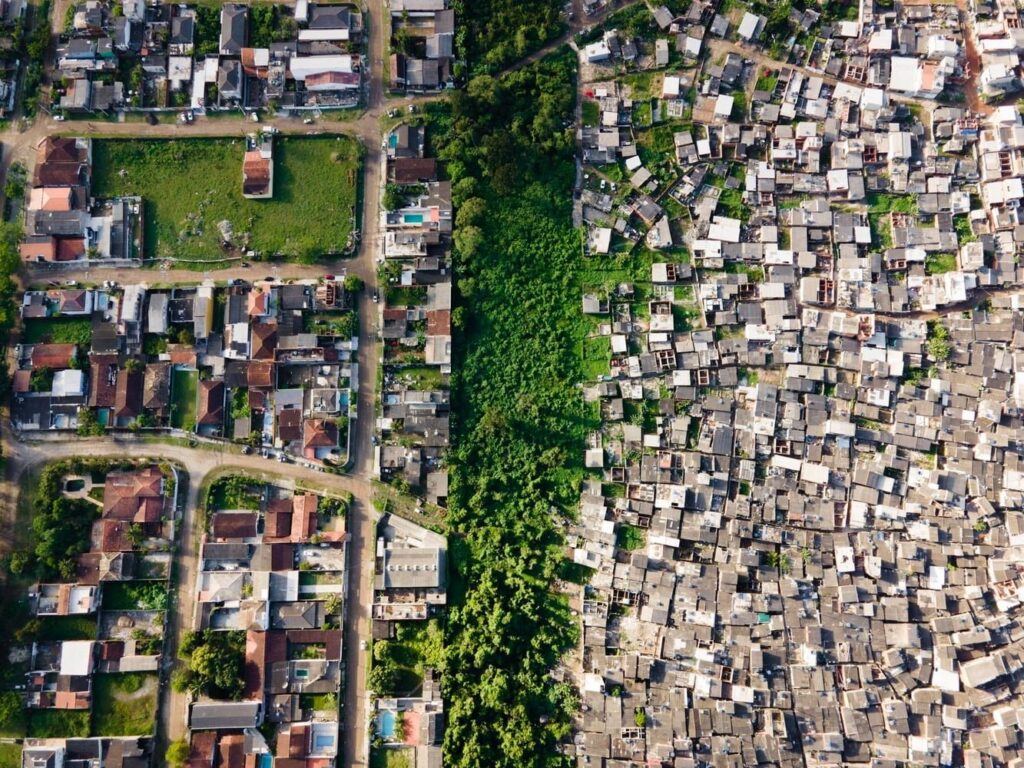The climate crisis of the 21st century affects populations unequally, with poor and racialised communities suffering disproportionately from what has been termed environmental racism. This phenomenon exacerbates inequalities and highlights the need for inclusive and intersectional policies to promote climate justice.
The climate crisis is one of the greatest challenges of the 21st century, affecting all nations and populations in different ways. However, its impacts are not evenly distributed: some communities face a disproportionate burden of negative impacts.
Poor and racially discriminated communities are doubly disadvantaged and suffer more from the effects of climate change. This phenomenon is often referred to as ‘environmental racism’.
The term ‘environmental racism‘ was coined in the 1980s by Dr Benjamin Franklin Chavis Jr, who observed that black Americans lived in inhospitable environments and were disproportionately affected by harmful environmental policies and practices.
Environmental racism is a term used to describe how the poorest and most marginalised populations are most affected by negative environmental impacts such as pollution, contamination and natural disasters.
It thus refers to the unequal distribution of the negative impacts of environmental degradation. These communities, usually made up of black and Latin American populations, face greater health risks, lose access to electricity and heat, and have difficulty recovering economically after extreme weather events.
In practice, the climate crisis exacerbates existing inequalities in society, which are often rooted in racism.
These populations, often with less political and economic power, live in high-risk areas, such as slums on landslide-prone hillsides. This situation is the result not only of geography, but also of historical policies of segregation and redlining. These policies have directed communities into less desirable and more dangerous areas, such as industrial zones, urban peripheries and areas with inadequate infrastructure, increasing their vulnerability to natural disasters.
It is also important to note that these communities face a greater burden of environmental pollutants. Areas inhabited by racial minorities and people with low incomes tend to have higher concentrations of air pollution, water pollution and toxic waste.
For example, in many places, power plants, factories and landfills are located near these communities, increasing their exposure to harmful pollutants. Prolonged exposure to these pollutants can lead to serious health problems such as respiratory and cardiovascular disease and cancer. These health problems are exacerbated by the effects of climate change, such as heat waves and extreme weather events, which disproportionately affect these communities.
Racial discrimination also manifests itself in unequal access to resources that are essential for adapting to and mitigating the effects of climate change. Resources such as finance, insurance, resilient infrastructure and government aid are often unequally distributed, favouring more privileged populations to the detriment of marginalised communities.
For example, when natural disasters strike, racial minority communities often face barriers to accessing emergency relief and recovery programmes. Furthermore, the lack of investment in resilient infrastructure in marginalised areas makes these communities more vulnerable to the impacts of the climate crisis, perpetuating a cycle of inequality and vulnerability.
In the international context, environmental racism is also manifested in the unequal relations between the global North and South, the result of colonialism and imperialist exploitation. In Latin American countries, for example, the consequences of imperialist competition and the exploitation of natural resources and labour fall disproportionately on marginalised populations.
Movement for environmental justice and inclusive policies
On a global scale, climate justice and racial justice are interconnected issues. The nations that contribute the least to the climate crisis are the most affected, and within developing countries, racial and social inequalities also determine who suffers the most.
The fight against environmental racism underlines the need for the equal participation of marginalised communities in environmental decision-making. Therefore, the development of adaptation and mitigation policies that take into account specific needs is crucial to equitably address the challenges posed by the climate emergency. These policies must include multiple integrated approaches that take into account the specificities of each community.
A key aspect is investment in infrastructure improvements, as many of these areas suffer from a lack of efficient drainage systems, which increases the risk of flooding, and a lack of green spaces, which could mitigate the effects of heat waves. Investing in the upgrading and maintenance of this infrastructure would not only reduce the risks associated with climate disasters but also improve the quality of daily life for local populations.
It is also essential to ensure equitable access to finance and insurance. Financial institutions and insurance companies must be regulated to avoid discrimination based on race or income. Facilitating access to these resources is essential for all communities to adequately prepare for future climate events and to rebuild after disasters.
As mentioned above, community participation must be a central pillar in the planning and implementation of climate policies. The active involvement of marginalised communities in decisions that affect their future ensures that their voices are heard and that their specific needs are addressed.
Participatory processes such as public consultations, community forums and local planning committees are essential to developing solutions that are truly inclusive and effective.
These interlinked approaches promote a more just and environmentally responsible response to climate change, recognising and addressing the historical inequalities that have exacerbated the vulnerability of marginalised communities.
The Global Centre for Climate Justice is a great example of the struggle for climate justice, promoting transformative policies and addressing the root causes of the climate crisis and social injustice.
Focusing on popular education, original research, movement networking, consultancy and outreach, the Centre takes an intersectional approach to analysing the links between class exploitation, systemic racism, gender oppression and political domination. The Centre emphasises the need for liberatory and practical solutions, arguing that it is the responsibility of the current generation to imagine and create a better future.
In short, the struggle for environmental justice is essential to addressing the climate crisis in a just and inclusive way. Environmental racism perpetuates the inequalities that exacerbate the impacts of climate change on marginalised communities. It is therefore imperative that adaptation and mitigation policies take into account the specific needs of these communities, focusing on improving infrastructure, ensuring equitable access to finance and insurance, and promoting the active participation of affected populations.
Complementary activities.
1 – – Watch the film ‘There’s Something in the Water’ (2019) – Directed by Ian Daniel, Elliot Page.
2 -Read the book ‘Toxic Communities: Environmental Racism, Industrial Pollution, and Residential Mobility’ (2014) by Dorceta Taylor.



